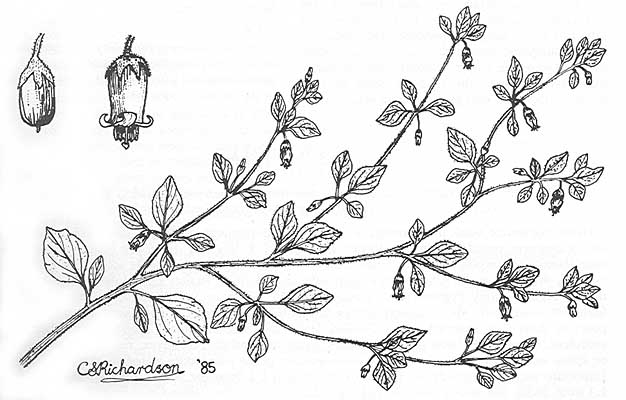
Synonymy
*Salpichroa origanifolia (Lam.) Baillon, Hist. Pl. 9: 288 (1888)
Physalis origanifolia Lam., Tabl. Encycl. 2: 28 (1794).
T: Not Australian; n.v.
S. rhomboidea (Hook.) Miers, London. J. Bot. 4: 326 (1845); Atropa rhomboidea Hook., Bot. Misc. 1: 135; t. 37 (1829).
T: Not Australian; n.v.
Description
Rhizomatous perennial to 30 cm, sparsely pubescent with minute, forked hairs at least on calyx margin.
Lower leaves alternate; lamina ovate-lanceolate, up to 5 cm long; upper leaves often 2 per node (but not opposite), lanceolate, c. 3 cm long; margin toothed or sinuate, sometimes entire; base cuneate; petiole to 2 cm long, narrowly winged above.
Pedicels 7–12 mm long. Calyx 6–10 mm long; lobes triangular, 2–4 mm long. Corolla rotate or 5–angled, 11–15 mm long, pale yellow, often with conspicuous olive-yellow blotches towards base. Anthers 3–4 mm long. Style 9–10 mm long.
Fruiting calyx 10–angled, 15–20 (occasionally to 30) mm long, dull yellow-green, drying to pale brown or straw-colour. Berry globular, 10–15 mm diam. Seeds disc-shaped, 1.7–2.3 mm long, pale yellow or light brown.
Distribution and ecology
Probably native to temperate South America but naturalised in North America, Europe, Africa and Australia.
Widespread in south-eastern Australia; occurs in all States but not N.T. Common in waste places, predominantly in urban areas.
Common name
Pampas, Lily of the Valley
Notes
An account of the weedy nature of this species can be found in W.T. Parsons & E.G. Cuthbertson, Noxious Weeds of Australia, Inkata Press, Melbourne (1992) 607–608.
Selected specimens
W.A.: Perth, 28 Mar. 1969, J.H. Paterson (PERTH). S.A.: Adelaide, D.E. Symon 11027 (AD). A.C.T.: Canberra, E. D'Arnay 743 (BRI, CANB, NSW). Vic.: Melbourne, T.B. Muir 5496 (MEL). Tas.: Burnie, 29 Oct. 1951, A.H.Woodforde (HO).
Derivation of epithet
From origanus, Latin for Oregano and folius, Latin for leaf, a reference to the resemblance of the leaves of this plant to those of Oregano.
Images and information on web
Further information can be dowloaded as a factsheet from the Weeds in Australia site.
An account of this species
and its occurrence in Tasmania as a declared weed can be found on the Department of Primary Industries, Water & Environment site at www.dpiwe.tas.gov.au/inter.nsf/WebPages/TPRY-5D8374?open There are also images of the plant at this site.Images and information about the presence of S. origanifolia or Pampas Lily-of-the-Valley as a noxious weed in Victoria can be found on the Department of Primary Industries site at http://www.dpi.vic.gov.au/dpi/vro/vrosite.nsf/pages/weeds_herbs_perennial_pampas_lily_valley
Photographs of flowers and leaves can be seen at www.biologie.uni-regensburg.de/Botanik/Schoenfelder/kanaren/images/Salpichroa_origanifolia.jpg and http://web.guernsey.net/~cdavid/botany/files/salpichroa%20origanifolium/index.html
The NSW flora treatment with description, map and image of an herbarium sheet can be seen on the PlantNet site at http://plantnet.rbgsyd.nsw.gov.au/cgi-bin/NSWfl.pl?page=nswfl&lvl=sp&name=Salpichroa~origanifolia
Plant status (if any)
A declared noxious weed in Vic. and Tas.; often difficult to eradicate because of its extensive root system.